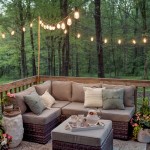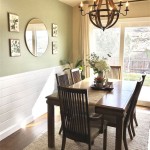How to Decorate Garden Walls: Transforming Boundaries into Beautiful Backdrops
Garden walls, often perceived as mere boundaries, possess the potential to become integral and visually appealing elements of outdoor spaces. Skillfully decorated garden walls can enhance the overall aesthetic, provide privacy, and even create microclimates suitable for specific plants. The following guidelines offer insights into various approaches to transforming these vertical surfaces into captivating visual features.
Vertical Gardening Techniques for Garden Walls
One of the most effective ways to decorate garden walls is through the incorporation of vertical gardening techniques. This approach involves training plants to grow upwards, covering the wall surface with greenery and blossoms. Several popular methods can be employed, each with its own advantages and aesthetic qualities.
Climbing Plants: The selection of appropriate climbing plants is crucial for successful vertical gardening. Considerations include the plant’s growth habit, sunlight requirements, and potential for invasiveness. Plants such as ivy (Hedera helix), climbing roses (Rosa spp.), wisteria (Wisteria sinensis), and clematis (Clematis spp.) are popular choices. Ivy, while providing excellent coverage, can become aggressive and damage the wall structure if not properly managed. Climbing roses offer beautiful blooms but require regular pruning and support. Wisteria is known for its stunning cascades of flowers but needs a sturdy trellis system to support its weight. Clematis offers a wide variety of flower colors and sizes and can be trained to grow on trellises or wire supports.
Prior to planting, it is important to assess the wall's condition. Cracks and loose mortar should be repaired to prevent future damage from the plant's root system. A suitable support structure, such as a trellis, wire grid, or individual plant supports, should be installed. The type of support will depend on the chosen plant and the desired aesthetic. For example, a delicate clematis might benefit from a fine wire mesh, while a heavy wisteria will require a robust wooden trellis.
Wall-Mounted Planters: Wall-mounted planters offer a more controlled and customizable approach to vertical gardening. These planters can be made from various materials, including terracotta, metal, plastic, and wood. Different sizes and shapes allow for creative arrangements and accommodate a variety of plant types. Succulents, herbs, and trailing flowers are particularly well-suited for wall-mounted planters.
Before installing wall-mounted planters, consider the weight they will bear when filled with soil and plants. Securely attaching the planters to the wall is essential to prevent them from falling. Use appropriate mounting hardware, such as screws and wall anchors, suitable for the wall material (brick, concrete, wood, etc.). The spacing between planters should also be carefully considered to allow plants adequate room to grow and prevent overcrowding. Regularly watering and fertilizing the plants in wall-mounted planters is crucial, as the limited soil volume can dry out quickly.
Living Walls: Living walls, also known as green walls or vertical gardens, are more complex systems that involve pre-planted panels or modular units attached to the wall. These systems often include built-in irrigation and drainage, making them relatively low-maintenance. Living walls offer a wide range of design possibilities, allowing for intricate patterns and diverse plant combinations.
Installing a living wall typically requires professional assistance, as it involves specialized knowledge of irrigation, drainage, and plant selection. The initial cost can be higher than other vertical gardening methods, but the long-term aesthetic and environmental benefits can be significant. The choice of plants for a living wall depends on the climate, sunlight exposure, and desired aesthetic. Considerations should be made to include plants that are compatible with each other and thrive in the vertical environment.
Decorative Elements for Enhancing Garden Walls
Beyond vertical gardening, decorative elements can significantly enhance the visual appeal of garden walls. These elements can add texture, color, and personality to the outdoor space.
Paint and Murals: Painting the garden wall is a simple yet effective way to transform its appearance. Light colors can create a sense of spaciousness, while bold colors can add vibrancy and energy. Consider the surrounding landscape and choose colors that complement the existing vegetation and architectural features. Weather-resistant paints specifically designed for exterior use are essential for durability.
Murals offer a more artistic and personalized approach to wall decoration. They can depict landscapes, abstract designs, or even portraits. Collaborating with a local artist can ensure a unique and high-quality mural that reflects the owner’s individual style. Before painting a mural, the wall surface should be thoroughly cleaned and primed to ensure proper paint adhesion.
Mirrors and Reflections: Strategically placed mirrors can create the illusion of greater space and reflect light into darker areas of the garden. Mirrors can be framed or frameless, depending on the desired aesthetic. Position mirrors carefully to avoid reflecting harsh sunlight directly into living spaces or creating glare that could be harmful to birds. Antique mirrors can add a touch of vintage charm, while modern mirrors can create a sleek and contemporary look.
Decorative Panels and Screens: Decorative panels and screens offer a versatile way to add texture, pattern, and privacy to garden walls. They can be made from various materials, including wood, metal, bamboo, and composite materials. Laser-cut panels with intricate designs can create stunning visual effects. Bamboo screens offer a natural and eco-friendly option. The choice of material and design should complement the overall garden style.
Sculptures and Art: Incorporating sculptures and art pieces into the garden wall design can add a touch of sophistication and artistic flair. Select sculptures that are appropriate in scale and style for the garden setting. Consider the material and durability of the sculpture, especially if it will be exposed to the elements. Art pieces can be hung directly on the wall or displayed on pedestals or shelves. The arrangement of sculptures and art should be carefully considered to create a balanced and visually appealing composition.
Functional Considerations for Garden Wall Decoration
When decorating garden walls, it is important to consider functional aspects in addition to aesthetic considerations. The decoration should not compromise the structural integrity of the wall or create safety hazards.
Drainage and Ventilation: Ensure that any decoration does not impede drainage or ventilation. Covering the entire wall surface with impermeable materials can trap moisture and lead to structural damage. Leave gaps and openings to allow air circulation and prevent the buildup of moisture. Properly draining the wall base is crucial to prevent water damage and erosion.
Lighting: Incorporating lighting into the garden wall design can enhance its beauty and functionality. Uplighting can highlight architectural features and sculptures. Downlighting can provide ambient illumination for pathways and seating areas. Solar-powered lights offer an energy-efficient and cost-effective option. Consider the color temperature and intensity of the lights to create the desired atmosphere. String lights can add a festive and whimsical touch.
Security: The decoration should not compromise the security of the property. Avoid creating easy access points for intruders. Trim climbing plants regularly to prevent them from becoming ladders. Choose decorative elements that are difficult to climb or remove. Consider installing security lighting to deter intruders. A well-maintained and visually appealing garden wall can also act as a deterrent to crime.
Maintenance: Regular maintenance is essential to keep garden walls looking their best. Clean the wall surface regularly to remove dirt, moss, and algae. Prune climbing plants to control their growth and prevent them from damaging the wall. Repair any cracks or damage promptly to prevent further deterioration. Inspect decorative elements regularly and replace them as needed. A little maintenance can go a long way in preserving the beauty and functionality of garden walls.
By considering these various aspects, individuals can transform their garden walls from simple boundaries into stunning focal points that enhance the overall beauty and functionality of their outdoor spaces. Careful planning, thoughtful selection of materials, and regular maintenance are key to achieving successful and long-lasting results.

How To Decorate Garden Walls Doğtaş

5 Spectacular Outdoor Wall Decor Ideas That You Ll Love Garden Patio

Ways To Decorate Your Garden Fence Diy Ideas Landscape Blessmyweeds Com Wall Decor Crafts Art

17 Best Garden Wall Ideas Walls To Diy

Garden Walls

17 Best Garden Wall Ideas Walls To Diy

Outdoor Wall Décor For Maryland And Dc Homes Winthorpe Design Build

19 Ingenious Garden Decorations That Will Impress You Small Gardens Vines Planning

Brillian Ideas For Your Garden Wall The Bugle Weekly Community Tabloid

39 Inspiring Garden Wall Ideas For An Impacting Backyard







